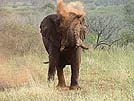CITES and Endangered Species.
Many species of animals and plants are used by man but they may be exploited to a level when they become endangered and even possibly extinct.
In 1973, a UN Conference on the Human Environment set up the ‘framework’ for CITES – Convention on International Trade in Endangered Species of Wild Flora and Fauna, and it came into force in 1975.

By August 1990 the convention had 109 signatories who would all contribute financially. It now has 167 different countries.
CITES does not seek to stop trade in wildlife completely, but rather to ‘encourage it in a sustainable way’.
 Activities:
Activities:
CITES has had considerable success in a number of well-known areas such as the ivory trade and turtle shell programmes:
 
| These, and many other programmes can be seen
from links on the  CITES website: CITES website: click on ‘special programmes’. |
Further information on ‘ivory poaching’ can be found at:
Some questions:

 Pollution
Pollution

What's your opinion?
Average rating




Not yet rated